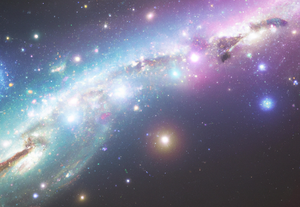
The Milky Way, our home galaxy, has had a pretty interesting past. It has grown over time by swallowing up several smaller satellite galaxies. These events added stars and gas to the Milky Way. However, finding out which stars formed in these satellite galaxies and determining the order of the mergers is difficult. It requires precise measurements of the ages, motions, and chemical composition of stars. Recently, such results were obtained in work done by two astronomers from the Nicolaus Copernicus Astronomical Centre (CAMK), Dr. Riano Giribaldi (currently at the Université libre de Bruxelles in Belgium) and Dr. hab. Rodolfo Smiljanic (CAMK professor).
They determined ages with errors between 6.5% and 10% for a sample of about 220 metal-poor stars with ages between 9 and 13.7 billion years. These are some of the most precise ages ever obtained for this type of stars. The ages were determined by isochrone fitting, a method based on the comparison between observed stellar properties, such as brightness and temperature, and theoretical models of stellar evolution. The high precision in the stellar ages was possible because the stellar properties needed for this comparison (temperature and surface gravities) were determined with errors below 1% in a previous work
.
Abundances for the chemical elements Mg, Si, Ca, Ti, Ni, Ba, and Eu, and the orbits of these stars in the Galaxy were also determined. Using all these data, the stars could be separated into three major groups that show different chemical enrichment histories. Two groups were previously known, called Gaia-Enceladus and Splash, but one is a new identification, here called Erebus (according to the Greek oral poet Hesiod’s Theogony, Erebus is the offspring of Chaos).
Gaia-Enceladus was the last large satellite galaxy to have merged with the Milky Way. In this work, the authors could measure that star formation in Gaia-Enceladus lasted for at least 3 billion years and stopped about 9.6 billion years ago. This moment marks with very high precision the last stage of its merging with the Milky Way. Splash stars were once part of the Milky Way disc, but were thrown into the Galactic halo because of perturbations created by the Gaia-Enceladus merger.
The newly identified population of stars called Erebus was found to be more metal rich than stars from Gaia-Enceladus at all ages. This suggests that these stars formed in a higher-mass galaxy, which is possibly the Milky Way itself. Erebus stars were probably part of the pre-existing halo and suffered perturbations from Gaia-Enceladus and other merger events.
The article, "Chronology of the chemical enrichment of the old Galactic stellar populations", by Riano Giribaldi and Rodolfo Smiljanic, with the results has been accepted for publication in A&A.
This research was supported by the National Science Center through the OPUS project ``Near-UV stellar spectroscopy: uncovering the past and building the future''. Project description.
Figure caption: Artistic representation of the merger between a larger galaxy (bottom left) and a smaller one (top right), such as likely happened in the past of the Milky Way (image generated using DALL-E).
Text: Rodolfo Smiljanic.






